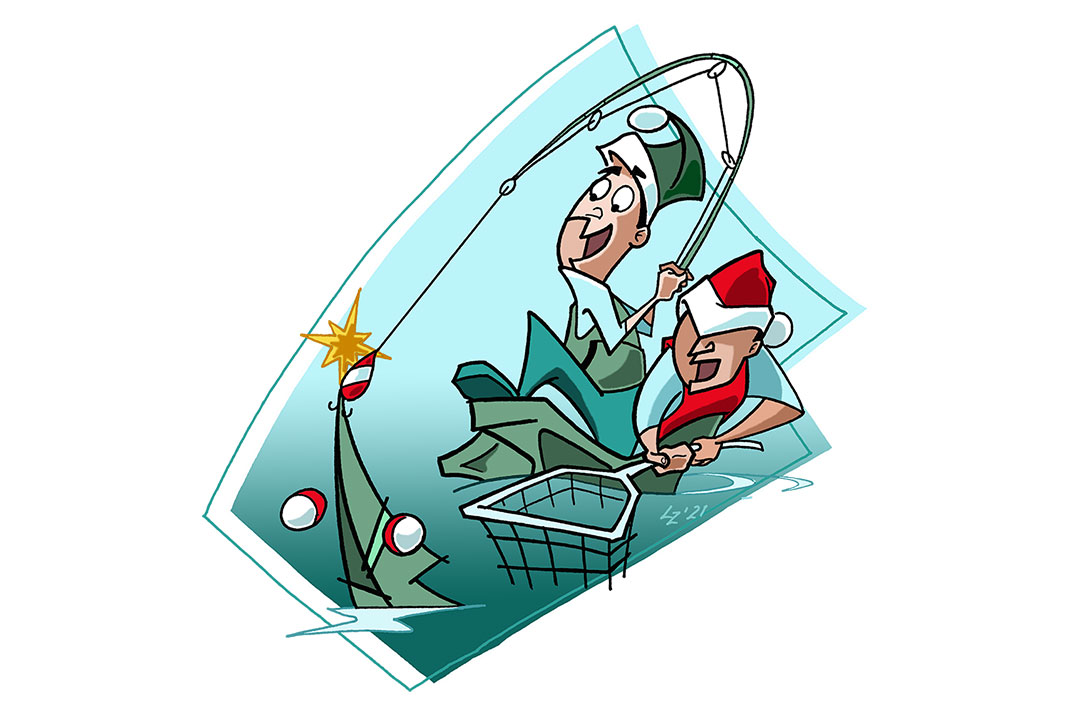Products You May Like
It wasn’t a hard hit. The rod just suddenly loaded and something heavy slid to the left with the brazen confidence of a really big fish. But my adversary didn’t dive or jump or shake and I soon realized I had hooked a thick, waterlogged branch.
River birch. I posed with it for a quick photo, then gently slid it back in the water to probably catch again another day. It got me thinking about all the excitement anglers owe structure, and how we can help make more of it. This holiday season, get into the giving spirit and recycle your Christmas tree by sinking it straight to the watery depths.
Turn Your Christmas Tree into Festive Fishing Structure
Fish are attracted to submerged structure. And they don’t seem to be too particular. A bag of golf clubs I threw in the water hazard last year is already a catfish-spawning cavity. At the bottom of my pond, there is an active site around a couple of wooden TV trays I flung into the water after my toddler kept pulling them down on himself.
Rage isn’t the only reason stuff is on the bottom; weather can contribute to the fishy places. The number of lawn chairs and trampolines in any suburban lake would astound you.

All Debris Is Not Made Equal
Fish aren’t the only creatures attracted to randomly scattered stuff. You can observe the same magnetic pull in people; just set some items out on your lawn early on a Saturday morning and observe cars screeching to a halt and neighbors emerging out of their houses like zombies on the scent of fresh brains.
Structure doesn’t just concentrate fish for fishermen. The scuttled items cultivate algae and plankton, starting the food chain and increasing the productivity of the entire system. There are huge oceanic artificial reef projects involving sunken ships, airplanes, subway cars and oil rig platforms. Almost any man-made junk can be fish structure.
Of course, I can get too much of a good thing. Heavy rains will wash logs and debris choking the water. As tempting as it may be, I can’t just chuck any old thing in the water. To prevent contamination from chemicals and other harmful stuff, leave sinking cars and ships to the pros.
5 Easy Steps for a Festive Fishing Reef
One of my favorite holiday traditions is the annual sinking of the Christmas tree. In fact, recycled Christmas trees are one of the most popular, effective and safe do-it-yourself fish reefs. What other holiday culminates with chucking the festive centerpiece in the nearest fishing hole?
Here are my five steps to enjoy the Christmas season and start a new year of fishing:
- Buy tree
- Decorate tree
- Admire tree and unwrap gifts
- Remove tree decorations
- Throw the tree in the lake
The tradition of housing an evergreen began sometime around 1,600 B.C., when a German father chopped down an evergreen and dragged it into his house. I’m sure his family was startled.
Soon after opening the presents, it is reported someone in the family started another tradition when they asked, “Großartig! Jetzt machen was wir damit?” Translated as: “Great, now what do we do with it?”
For the kayak angler who has everything, a Christmas tree can be the gift that keeps giving. After boxing the decorations, unwinding the lights and picking off tinsel, wire the tree to a cinder block. Then, go ahead and decorate the tree with a couple old lures—they’ll end up stuck in the branches eventually.
Selecting the Best Christmas Tree to Sink
As a submerged fish structure, hardwoods last longer than spruce, pine and such. However, you’re bound to meet resistance from the family if you suggest caroling around ye olde leaf-barren oak.
Fish are not impressed with commercially grown, manicured evergreen trees with long needles and bushy branches. For the best fish-hiding structure, look for a scrawny tree with bald spots. I use this equation: the more ornaments a tree can hold the more minnows it will hide.
The need is real. As a lake ages, cover diminishes. Annual community brush pile drop events help productive fisheries return. Leftover Christmas trees are readily available, relatively low-cost, environmentally friendly, and except for a little bit of leftover tinsel, all-natural.
Plus, on your next fishing trip, you might be surprised that hooking a Christmas tree will get your heart racing. With the right tackle, they put up a pretty good fight.

